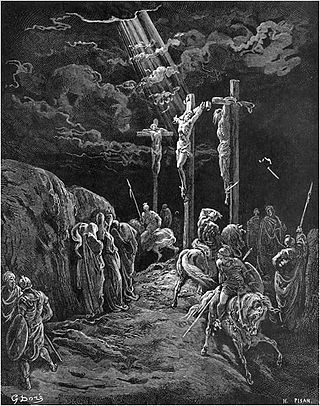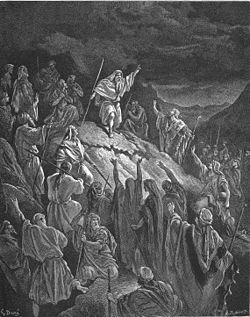|
Scene |
Image |
Book/chapter/verse depicted |
|---|
| 1 |
"The Creation of Light" |
 |
Genesis 1:3 |
| 2 |
"The Formation of Eve"
(or "The Creation of Eve") |
 |
Genesis 2:21-22 |
| 3 |
"Adam and Eve Driven Out of Eden" |
 |
Genesis 3:24 |
| 4 |
"Cain and Abel Offering Their Sacrifices" |
 |
Genesis 4:3-5 |
| 5 |
"The Death of Abel"
(or "Cain Slays Abel") |
 |
Genesis 4:8-9 |
| 6 |
"The World Destroyed by Water" |
 |
Genesis 7:24 |
| 7 |
"The Deluge"
(or "The Great Flood") |
 |
Genesis 8:3-4 |
| 8 |
"The Dove Sent Forth from the Ark" |
 |
Genesis 8:11 |
| 9 |
"Noah Cursing Canaan"
(or "Noah Curses Ham and Canaan") |
 |
Genesis 9:24-25 |
| 10 |
"The Confusion of Tongues" |
 |
Genesis 11:6-8 |
| 11 |
"Abraham Journeying into the Land of Canaan" |
 |
Genesis 12:1 |
| 12 |
"Abraham and the Three Angels" |
 |
Genesis 18:9-10 |
| 13 |
"The Flight of Lot" |
 |
Genesis 19:24-26 |
| 14 |
"The Expulsion of Ishmael and His Mother" |
 |
Genesis 21:14 |
| 15 |
"Hagar and Ishmael in the Wilderness" |
 |
Genesis 21:17-18 |
| 16 |
"The Trial of Abraham's Faith" |
 |
Genesis 22:10-12 |
| 17 |
"The Burial of Sarah" |
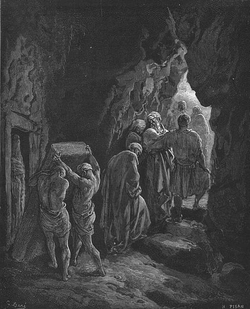 |
Genesis 23:19 |
| 18 |
"Eliezer and Rebekah" |
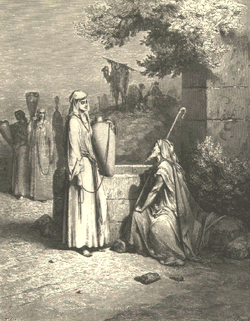 |
Genesis 24:16 |
| 19 |
"The Meeting of Isaac and Rebekah" |
 |
Genesis 24:65-67 |
| 20 |
"Isaac Blessing Jacob" |

|
Genesis 27:29 |
| 21 |
"Jacob's Dream" |
 |
Genesis 28:12 |
| 22 |
"Jacob Keeping Laban's Flocks"
(or "Jacob Tends Laban's Flocks and Meets Rachel") |
 |
Genesis 29:1-20 |
| 23 |
"The Prayer of Jacob"
(or "Jacob Prays for Protection") |
 |
Genesis 32:11 |
| 24 |
"Jacob Wrestling with the Angel" |
 |
Genesis 32:24 |
| 25 |
"The Meeting of Jacob and Esau" |
 |
Genesis 33:3-4 |
| 26 |
"Joseph Sold by His Brethren" |
 |
Genesis 37:28 |
| 27 |
"Joseph Interpreting the Pharaoh's Dream" |
 |
Genesis 41:25-26 |
| 28 |
"Joseph Makes Himself Known to His Brethren"
(or "Joseph Reveals Himself to His Brothers") |
 |
Genesis 45:1 |
| 29 |
"Jacob Goeth Into Egypt" |
 |
Genesis 46:5 |
| 30 |
"The Child Moses on the Nile" |
 |
Exodus 2:3 |
| 31 |
"The Finding of Moses" |
 |
Exodus 2:6 |
| 32 |
"Moses and Aaron Before Pharaoh" |
 |
Exodus 7:10 |
| 33 |
"The Murrain of Beasts"
(or "The Fifth Plague: Livestock Disease") |
 |
Exodus 9:2-3 |
| 34 |
"The Plague of Darkness"
(or "The Ninth Plague: Darkness") |
 |
Exodus 10:22 |
| 35 |
"The Firstborn Slain" |
 |
Exodus 12:29-30 |
| 36 |
"The Egyptians Urge Moses to Depart" |
 |
Exodus 12:31 |
| 37 |
"The Egyptians Drowned in the Red Sea" |
 |
Exodus 14:27 |
| 38 |
"Moses Striking the Rock in Horeb" |
 |
Exodus 17:6 |
| 39 |
"The Giving of the Law Upon Mt. Sinai" |
 |
Exodus 19:18 |
| 40 |
"Moses Coming Down From Mt. Sinai" |
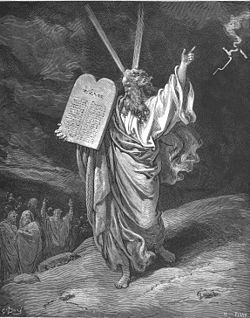 |
Exodus 32:15 |
| 41 |
"Moses Breaking the Tablets of the Law" |
 |
Exodus 32:19 |
| 42 |
"Return of the Spies from the Land of Promise" |
 |
Numbers 13:27 |
| 43 |
"Death of Korah, Dathan, and Abiram" |
 |
Numbers 16:32 |
| 44 |
"The Brazen Serpent"
(or "The Bronze Serpent") |
 |
Numbers 21:9 |
| 45 |
"The Angel Appearing to Balaam" |
 |
Numbers 22:23 |
| 46 |
"The Children of Israel Crossing Jordan" |
 |
Joshua 3:17 |
| 47 |
"The Angel Appearing to Joshua" |
 |
Joshua 5:9-15 |
| 48 |
"The Walls of Jericho Falling Down" |
 |
Joshua 6:20 |
| 49 |
"Joshua Spares Rahab" |
 |
Joshua 6:25 |
| 50 |
"The Stoning of Achan" |
 |
Joshua 7:25 |
| 51 |
"Joshua Committing the Town of Ai to the Flames" |
 |
Joshua 8:20 |
| 52 |
"Destruction of the Army of the Amorites" |
 |
Joshua 10:11 |
| 53 |
"Joshua Commanding the Sun to Stand Still" |
 |
Joshua 10:13 |
| 54 |
"Jael and Sisera" |
 |
Judges 4:21 |
| 55 |
"Deborah" |
 |
Judges 5:7-9 |
| 56 |
"Gideon Choosing His Soldiers" |
 |
Judges 7:7 |
| 57 |
"The Midianites Put to Flight" |
 |
Judges 7:22-23 |
| 58 |
"Death of the Sons of Gideon" |
 |
Judges 9:5 |
| 59 |
"Death of Abimelech" |
 |
Judges 9:52-53 |
| 60 |
"Jephthah's Daughter Coming to Meet Her Father" |
 |
Judges 11:34 |
| 61 |
"The Daughters of Israel Lamenting the Daughter of Jephthah" |
 |
Judges 11:40 |
| 62 |
"Samson Slaying a Lion" |
 |
Judges 14:5-6 |
| 63 |
"Samson Destroying the Philistines With the Jawbone of an Ass" |
 |
Judges 15:15 |
| 64 |
"Samson Carrying Away the Gates of Gaza" |
 |
Judges 16:3 |
| 65 |
"Samson and Delilah" |
 |
Judges 16:17 |
| 66 |
"Death of Samson" |
 |
Judges 16:30 [he] |
| 67 |
"The Levite Finding the Corpse of the Woman" |
 |
Judges 19:25-27 |
| 68 |
"The Levite Bearing Away the Body of the Woman" |
 |
Judges 19:30 |
| 69 |
"The Children of Benjamin Carrying Off the Virgins of Jabesh-Gilead" |
 |
Judges 21:12 |
| 70 |
"Naomi and Her Daughters-In-Law" |
 |
Ruth 1:16 |
| 71 |
"Boaz and Ruth" |
 |
Ruth 2:22-23 |
| 72 |
"Return of the Ark to Bethshemesh" |
 |
1 Samuel 6:13 |
| 73 |
"Samuel Blessing Saul" |
 |
1 Samuel 9:21 |
| 74 |
"Death of Agag" |
 |
1 Samuel 15:33 |
| 75 |
"David and Goliath" |
 |
1 Samuel 17:50 |
| 76 |
"Saul Attempts the Life of David" |
 |
1 Samuel 18:11-12 |
| 77 |
"The Escape of David Through the Window" |
 |
1 Samuel 19:11-12 |
| 78 |
"David and Jonathan" |
 |
1 Samuel 20:42 |
| 79 |
"David Showing Saul that He had Spared His Life" |
 |
1 Samuel 24:10 |
| 80 |
"Saul and the Witch of Endor" |
 |
1 Samuel 28:7 |
| 81 |
"Death of Saul" |
 |
1 Samuel 31:5-6 |
| 82 |
"Combat Between the Champions of Ish-Bosheth and David" |
 |
2 Samuel 2:15-17 |
| 83 |
"David Punishing the Ammonites" |
 |
2 Samuel 12:31 |
| 84 |
"Death of Absalom" |
 |
2 Samuel 18:9 |
| 85 |
"David Mourning the Death of Absalom" |
 |
2 Samuel 18:33 |
| 86 |
"Rizpah's Kindness Unto the Dead" |
 |
2 Samuel 21:9-10 |
| 87 |
"Abishai Saves the Life of David" |
 |
2 Samuel 21:17 |
| 88 |
"Judgment of Solomon" |
 |
1 Kings 3:25-27 |
| 89 |
"Cutting Down Cedars for the Construction of the Temple" |
 |
1 Kings 5:5-6 |
| 90 |
"The Disobedient Prophet Slain by a Lion" |
 |
1 Kings 13:24-25 |
| 91 |
"Elijah Raiseth the Son of the Widow of Zarephath" |
 |
1 Kings 17:22-23 |
| 92 |
"Slaughter of the Prophets of Baal" |
 |
1 Kings 18:38-40 |
| 93 |
"Elijah Nourished by an Angel" |
 |
1 Kings 19:5-6 |
| 94 |
"Slaughter of the Syrians by the Children of Israel" |
 |
1 Kings 20:29 |
| 95 |
"Death of Ahab" |
 |
1 Kings 22:35 |
| 96 |
"Elijah Destroys the Messengers of Ahaziah by Fire" |
 |
2 Kings 1:10 |
| 97 |
"Elijah Taken Up To Heaven in a Chariot of Fire" |
 |
2 Kings 2:11 |
| 98 |
"The Children Destroyed by Bears" |
 |
2 Kings 2:23-24 |
| 99 |
"The Famine in Samaria" |
 |
2 Kings 6:25-26 |
| 100 |
"The Death of Jezebel" |
 |
2 Kings 9:33 |
| 101 |
"Jehu's Companions Finding the Remains of Jezebel" |
 |
2 Kings 9:34-35 |
| 102 |
"The Strange Nations Slain by the Lions of Samaria" |
 |
2 Kings 17:25 |
| 103 |
"Destruction of the Army of Sennacherib" |
 |
2 Kings 19:35 |
| 104 |
"Slaughter of the Sons of Zedekiah Before Their Father" |
 |
2 Kings 25:7 |
| 105 |
"The Inhabitants of Jabesh-Gilead Recovering the Bodies of Saul and His Sons" |
 |
1 Chronicles 10:12 |
| 106 |
"Plague of Jerusalem" |
 |
1 Chronicles 21:16 |
| 107 |
"Solomon" |
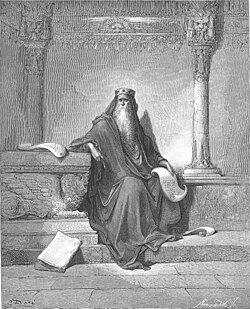 |
2 Chronicles 1:10 |
| 108 |
"Solomon Receiving the Queen of Sheba" |
 |
2 Chronicles 9:1-2 |
| 109 |
"The Destruction of the Armies of the Ammonites and Moabites" |
 |
2 Chronicles 20:22-23 |
| 110 |
"Death of Athaliah" |
 |
2 Chronicles 23:13-15 |
| 111 |
"Cyrus Restoring the Vessels of the Temple" |
 |
Ezra 1:7-8 |
| 112 |
"The Rebuilding of the Temple" |
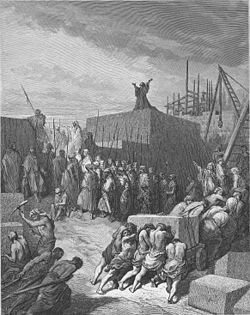 |
Ezra 3:11 |
| 113 |
"Artaxerxes Granting Liberty to the Jews" |
 |
Ezra 7:13 |
| 114 |
"Ezra in Prayer" |
 |
Ezra 9:6 |
| 115 |
"Nehemiah Viewing Secretly the Ruins of the Walls of Jerusalem" |
 |
Nehemiah 2:13 |
| 116 |
"Ezra Reading the Law in the Hearing of the People" |
 |
Nehemiah 8:5-6 |
| 117 |
"The Queen Vashti Refusing to Obey the Command of Ahasuerus" |
 |
Esther 1:11-12 |
| 118 |
"Triumph of Mordecai" |
 |
Esther 6:11 |
| 119 |
"Esther Accusing Haman" |
 |
Esther 7:5-6 |
| 120 |
"Job Hearing of His Ruin" |
 |
Job 1:20-22 |
| 121 |
"Job and His Friends" |
 |
Job 2:11-13 |
| 122 |
"Isaiah" |
 |
Isaiah 6:8-9 |
| 123 |
"Isaiah's Vision of the Destruction of Babylon" |
 |
Isaiah 13:20-21 |
| 124 |
"The Destruction of Leviathan" |
 |
Isaiah 27:1 |
| 125 |
"Jeremiah" |
 |
Jeremiah 1:14-15 |
| 126 |
"Baruch Writing Jeremiah's Prophecies" |
 |
Jeremiah 36:4 |
| 127 |
"The People Mourning Over the Ruins of Jerusalem" |
 |
Lamentations 1:8 |
| 128 |
"Ezekiel Prophesying" |
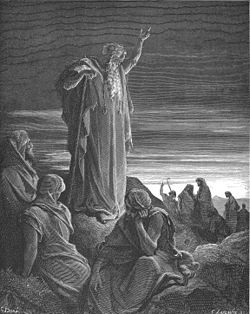 |
Ezekiel 1:3 |
| 129 |
"The Vision of the Valley of the Dry Bones" |
 |
Ezekiel 37:4-5 |
| 130 |
"Daniel" |
 |
Daniel 2:20-21 |
| 131 |
"Shadrach, Meshach, and Abednego in the Fiery Furnace" |
 |
Daniel 3:28/3:95 |
| 132 |
"Daniel Interpreting the Writing on the Wall" |
 |
Daniel 5:5-6 |
| 133 |
"Daniel in the Den of Lions" |
 |
Daniel 6:20-21/6:21-22 |
| 134 |
"The Vision of the Four Beasts" |
 |
Daniel 7:2-3 |
| 135 |
"Amos" |
 |
Amos 1:1 |
| 136 |
"Jonah Cast Forth by the Whale" |
 |
Jonah 2:1,10/2:2, 11 |
| 137 |
"Jonah Preaching to the Ninevites" |
 |
Jonah 3:4-5 |
| 138 |
"Micah Exhorting the Israelites to Repentance" |
 |
Micah 6:7-8 |
| 139 |
"The Vision of the Four Chariots" |
 |
Zechariah 6:1 |
|
